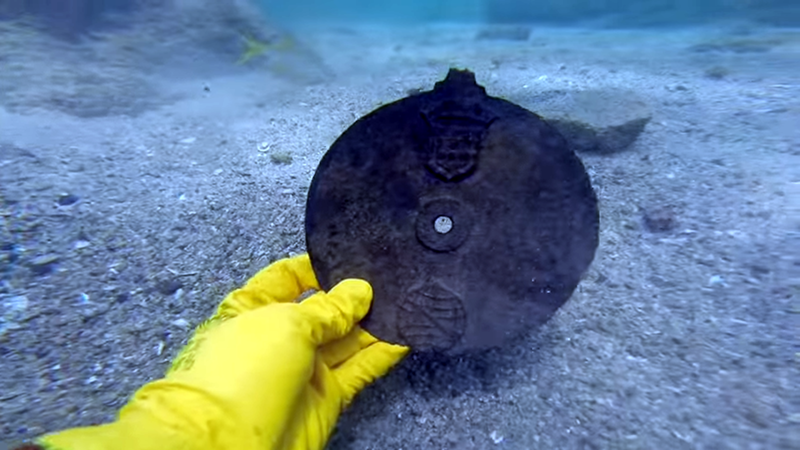We might not think of analog computers as having existed in the 1500s, but in fact the astrolabe first appeared around 220 BC. However, as you might expect only a few very old ones still exist. Early astrolabes were often wooden and were difficult to use aboard ships, however brass astrolabes with special features were more accurate on the deck of a ship underway. A recent archeological find from one of Vasco da Gama’s ships that sunk in the Arabian Sea has brought the number of known archeologically-significant instruments to 104, and also is one of the few nautical versions to employ a solid disk. As of now, it is the oldest known maritime astrolabe found so far — the ship sunk in 1503. You might wonder how the 104th astrolabe became number 108, but the catalog includes a few pieces or fragments of astrolabes. If you count those, there are 108 items in the catalog.
If you think archeology is about men in fedoras carrying whips, or stuffy old men wandering around tombs, you should have a look at the article about this find. In addition to divers recovering the piece from the shipwreck (see the video, below), the science involved in restoring it and analyzing it includes chemistry, lasers, X-rays, and energy-dispersive spectroscopy.
If you know how to use it, an astrolabe can identify stars and planets, determine the local latitude if you know the time, or — if you know the latitude — tell you the time. It can also help with surveying and triangulation. Not bad for something invented over 2,000 years ago.
The history of this particular astrolabe involves an early Portuguese voyage to India. Two brothers — related to da Gama — commanded two ships that both sunk while anchored at an island known as Al Hallaniyah, while waiting out a monsoon.
The cataloging effort has a long history, itself. As you might expect, it is an ongoing work as they never know when a new astrolabe will turn up. If you don’t feel like diving around old shipwrecks you can always make your own, but it won’t make it into the catalog for a few hundred years. We’ll agree the Antikythera mechanism is more impressive and older, but astrolabes were a lot more common.
















The Antikithera Mechanism is stil the most astonishing, IMO. https://en.wikipedia.org/wiki/Antikythera_mechanism
And subtly horrifying considering that, as far as I know, we still have no clue as to where it came from or who built it.
I mean consider all of the effort, the knowledge & research, honing of skills, YEARS of people’s lives invested in the creation of that device. And the only evidence we have of their accomplishments? The device itself.
You’d think that a device as sophisticated as that would’ve brought it’s builders and nation SOME notoriety from the scholars and historians of that time.
A good example of the 19 year Lunar cycle (which it tracks) occurred last night, the first Full Moon on the Spring Equinox in 19 years.
IMS only about 1% of the literature survives from that era. The
Clickspring is doing a beautiful and fantastic job of recreating the Antikithera Mechanism.
https://www.youtube.com/watch?v=ML4tw_UzqZE&list=PLZioPDnFPNsHnyxfygxA0to4RXv4_jDU2
I think you mean it can show you the time if you know your longitude and vice versa. Latitude is your distance north or south of the equator. An astrolabe can measure that.
Longitude is your distance east or west of the Prime Meridian at Greenwich, England. If you measure your local time by the noon day sun and compare it to the time at Greenwich, you can calculate your longitude. You need an accurate clock to tell the time in Greenwich.
there is a book about it https://en.wikipedia.org/wiki/Longitude_(book) explaining the problem and the solution found almost 300 year after… so on an astrolabe no Longitude! i get them wrong all the time myself
Latitude is like a ladder (parallel lines on a map)
Longitude is like long johns hanging on a clothes line.
And if you have trouble spelling “parallel”, (some people do),
just remember it has a pair of lines (double L) in it.
+ this. And the most accurate ships clocks were developed by John Harrison in the Longitude Prize competition which he won but was not awarded anything till he was 80 years old. Somewhere on youtube is an excellent video about his special escapement mechanism.
Are you referring to the 2000 movie “Longitude”, with Jeremy Irons?
https://www.imdb.com/title/tt0192263/
Clickspring is building a replica using the tools and materials of the day. The videos are absolutely fascinating. Ever wonder how to make a hardened file in 10 BC? He shows you.
https://youtu.be/ML4tw_UzqZE
I wouldn’t say it’s from 1503. The ship sank in 1503. This was probably around for some time before that
Yes, I agree, but you can only prove 1503.
PORTUGAL CARALHO!!!
Calculator, not computer.
I would argue that like a flight computer (a.k.a. “whiz wheel”, nav disc, or the more common E-6/B), an astrolabe given a set of inputs will compute a set of outputs. ;-)
The circular feature on the disk shown in the main picture here has got to make flat-earthers cringe and the people who hate them smile. It sure looks like a projection of a 3d spherical object onto the more-or-less flat surface.
It’s missing parts.